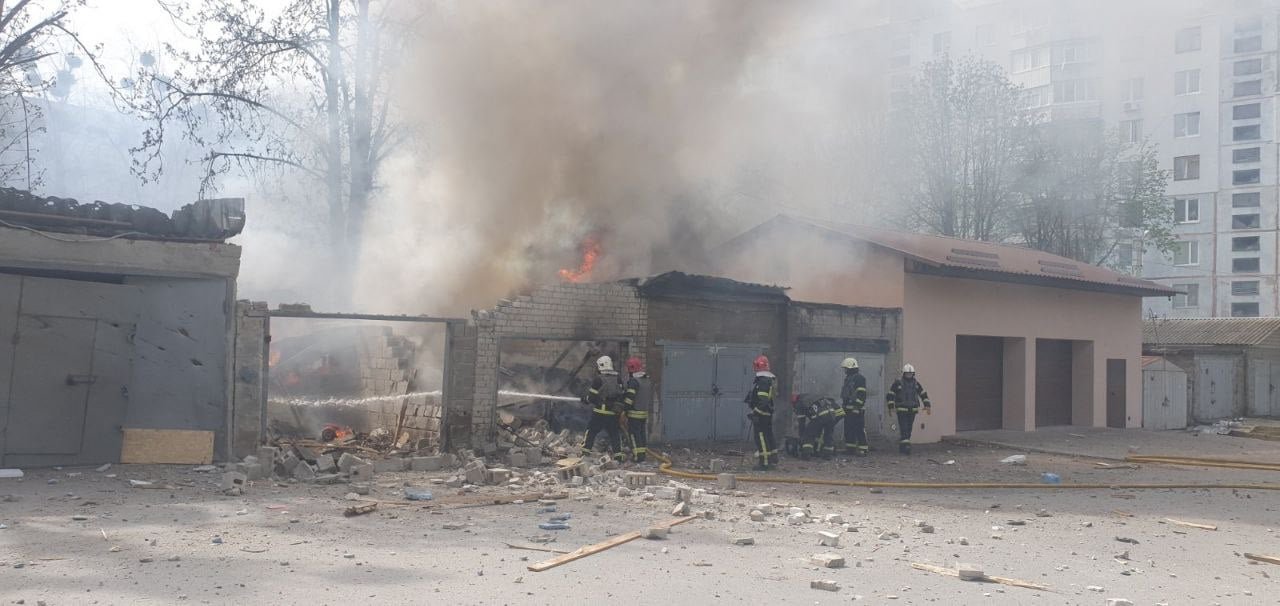By Serhiy Petrov
Today was another difficult day for Kharkiv and Kharkivites due to numerous muscovite attacks. Once again, there was massive artillery shelling of residential areas, resulting in deaths and many injuries. However, Kharkiv holds on, continues to defend itself and most importantly continues to live.
The overall amount of russist shelling was significant. The night from Monday to Tuesday was tough, with different areas of the city targeted with artillery fire. There was also intense muscovite shelling in the morning and the daytime. In the afternoon it got relatively quiet in some areas, while in others the attacks only somewhat decreased in intensity. The amount of shells increased again in teh evening. The occupiers fired mostly at various districts of Saltivka, Obriy, and the Kharkiv Tractor Plant neighborhood. Selyshche Zhukovskoho, Pyatykhatky, and Oleksiyivka also got hit a lot. In the afternoon, Skhidna Saltivka was fired upon by multiple rocket launcher systems, which killed four people, injured 26; more than 10 houses were damaged, as well as garages, shops, and cars.

Muscovite shelling continues in the suburbs: in the Derhachi Hromada and the town of Derhachi, and in the Chuhuiv direction. Meanwhile, power and gas companies in Derhachi are trying to rebuild damaged systems and supply people who stayed in the hromada with gas and electricity.
Authorities are asking Kharkiv residents to stay in shelters all the time and avoid going outside unless absolutely necessary, because the daily massive shelling of different parts of the city results in many deaths and injuries.
According to the Kharkiv City Council, 1,929 residential buildings (about a quarter of the city’s stock of such buildings) have been damaged and destroyed by muscovite artillery fire, missiles, and air strikes. This is a colossal number, which, unfortunately, will continue to grow. Meanwhile, the development of a new master plan for Kharkiv has begun, together with the British architect Norman Foster. It’s a good idea, but my position is that all the buildings that are historical and architectural monuments should be preserved and rebuilt (many of the damaged and destroyed buildings in the city center are such buildings), but all the others should fit into the overall architectural style of the city center. Residential areas can be rebuilt and replanned, since the Soviet-era cookie-cutter boxes are often placed randomly around neighborhoods. I hope that Kharkiv architects and cultural leaders, people who care about cultural heritage, will be able to join this process. But I am sure that local authorities will hinder this process, considering how many monuments in Kharkiv have been destroyed by the city with silent consent of the regional authorities and barbarically rebuilt (add-on attics, for example) despite public protests. The beneficiaries of such buildings or the free area under them have always been developers with close ties to city authorities.
The good news is that paramedics from the United States, who have extensive experience in hotspots like Iraq and Syria, have arrived in Kharkiv. They brought medicine for field hospitals and will train and advise Ukrainian paramedics.
It turns out that the evacuation of animals from the Feldman Ecopark isn’t over and still ongoing. It’s also come to light that two employees of the Ecopark, who remained there in March to feed the animals but disappeared in early March, were killed by the russists and barricaded in one of the rooms.
Fighting continues in the Izium area and in the Barvinkove direction. The courageous Armed Forces are holding back the muscovite onslaught, preventing them from breaking through. At the same time, the muscovites were able to get within 10 km of Lyman (Donezk region). Another Ka-52 helicopter was shot down by the Ukrainian military in the Kharkiv region. Also, the evacuation of the population from Barvinkove and Lozova continues. In Lozova, public utilities are sustaining the city’s livelihood.
The situation in the occupied territories of the Kharkiv region is difficult. In Velykoburlutska Hromada, the occupiers left mines on all minor roads, road shoulders, windbreaks, dirt roads, fields, and forests to prevent humanitarian aid volunteers from traveling there (the “unsanctioned,” non-muscovite volunteers), as well as Ukrainian sabotage and reconnaissance groups (actually, they’re just afraid of an advance by our troops). The russists also restrict the movement of local residents on major roads. In the village of Borova in the southeast of the Kharkiv region, muscovites appointed their commandant. We know that his name is Sergei Razdorozhny, whom Google identifies as the head of the Novosibirsk military commandant’s office. The occupiers plan to annex Borova to the so-called “Luhansk People’s Republic.” The occupiers did not allow the humanitarian cargo to be brought to Borova, confiscating it. There is no communication with the Borova Hromada (same with the rest of the temporarily occupied territories in the region), there is a problem with food, and there is a strict regime of checkpoints, preventing people from going to the territory controlled by Ukraine, and only allowing travel to moscovia. Of course, the russists are looting and being cruel to the local population.
Heavy fighting continues in the Joint Forces Operation zone and along the entire front line. In the north of the zone, battles are ongoing for Rubizhne, Popasna, and in the Kreminna area. Severodonetsk and Lysychansk are also under fire. There’s fighting in the Avdiivka and Marinka area. Attempts to advance run into our defenses, which force the muscovites to return to their previous positions. A missile strike was fired on Kramatorsk; one person was killed and three injured. Fighting is also taking place in the area of Vuhledar, Velyka Novosilka, the Donetsk region, and Huliaipole in Zaporizhzhya. The strikes on Huliaipole are of an ancillary nature, even though the russists are probing everywhere, checking for any weaknesses in the defense.
Things are difficult in Mariupol, but its heroic defenders continue holding on. Heavy bombs have been dropped on Azovstal, and all sorts of weapons are being fired upon it, even though there are more than a thousand women and children hiding inside with, unfortunately, very little food left.
The muscovites are trying to establish their power in the temporarily occupied territories of southern Ukraine. Thus, in the village of Rozivka, they gathered about a hundred retirees from the district and at these pseudo-meetings voted to annex the Rozivka district (liquidated in 2020 during the administrative-territorial reform of decentralization) to the occupied Donetsk and Luhansk regions (controlled by moscovia, the so-called Donetsk People’s Republic ”). In Energodar, the muscovites put Vadim Karetnikov, a former electrician at the Zaporizhzhya nuclear plant who has nothing to do with education but is an active supporter of the “ruZZ measure,” in charge of the city gymnasium. In the village of Kostiantynivka, in the Melitopol district, women who agreed to cooperate with the occupiers became school principals. At the schools, the muscovites have been dismantling memorial plaques to the schools’ graduates who had fallen in the war. It matters to them who has a monument, and who has a memorial plaque dedicated to them, or how a street is named. They destroy any Ukrainian markers in the occupied territories, because for them, this is already moscovia, since there are muscovite soldiers there.
In addition to the “referendum” in Kherson, the russists are preparing the same formal “referendum” in Snihurivka, in the Mykolayivska Region, which is temporarily occupied. They plan to annex the city to the previously occupied Crimea. The forced deportation of Ukrainians to moscovia is also underway. More than 500,000 Ukrainian citizens have already been evicted this way, including more than 121,000 children.
There is more positive news. First, we got fighter jets (probably SU and MiGs from Central and Eastern Europe) and spare parts for them (this is good news, which I was aware of earlier but, of course, was silent). Secondly, there are heavy weapons, both armored vehicles and artillery.
Third, the list includes the Netherlands, which could not help but troll the Germans: “We are not Germans” was the motto of the arms transfer to Ukraine. (Yes, such relations are quite normal and expected, given some aspects of the history of the Dutch and the Germans). The lend-lease is gradually starting to work at full capacity. It will take a few more weeks for it to become fully operational.
In one of the epic stories, in the Kharkiv region police stopped a Porsche Cayenne, where they found a pile of ammunition including 208 rounds, eight grenades, and three submachine guns.
The Kharkiv studio “Old Circus” (there are two circus buidings in Kharkiv: the old one, which is no longer used as a circus, and the new Soviet-era building on Bugrymova Square) took part in the international circus festival in Monte Carlo, where they presented a play about Ukrainian soldiers.
Today’s Darwin Award goes to:
- Two brothers: the Minister of Education and Science of Ukraine and well-known plagiarist Serhiy Shkarlet, and the rector of the National Aviation University in Kyiv Maksimka Lutsky, who was appointed through machinations by the Ministry of Shkarlet to eliminate the previous, competent leadership. That’s because a protégé of Yanukovych-Tabachnyk (Shkralet also pushed Tabachnyk’s career), known for using hard administrative resources against NAU students and teachers during the election and constantly trying to steal NAU lands to build “his own.” So, these two came to Irpin and took pictures of themselves wearing the old Ukrainian military uniform circa 2014, holding the weapon incorrectly (finger on the trigger). Goddamn “warriors!”
- The muscovites who are trying to invent hundreds of new explanations for why the missile cruiser “Moskva” sunk: that she was attacked by Ukraine’s entire air force, including all of its “Bayraktars” and all of Ukraine’s “Neptunes” (even the theoretical ones), and could not defend herself, because she was surrounded by civilian ships. She protected them by getting between them and the Neptunes. It’s dumb, but it’s better than one of the early versions of events, in which someone had simply smoked a cigarette in the wrong spot on the ship, detonating its munitions.
Let us believe in the Armed Forces! Let us help volunteers, doctors, public utility workers, and rescuers. And let us bring closer the day of our victory!








